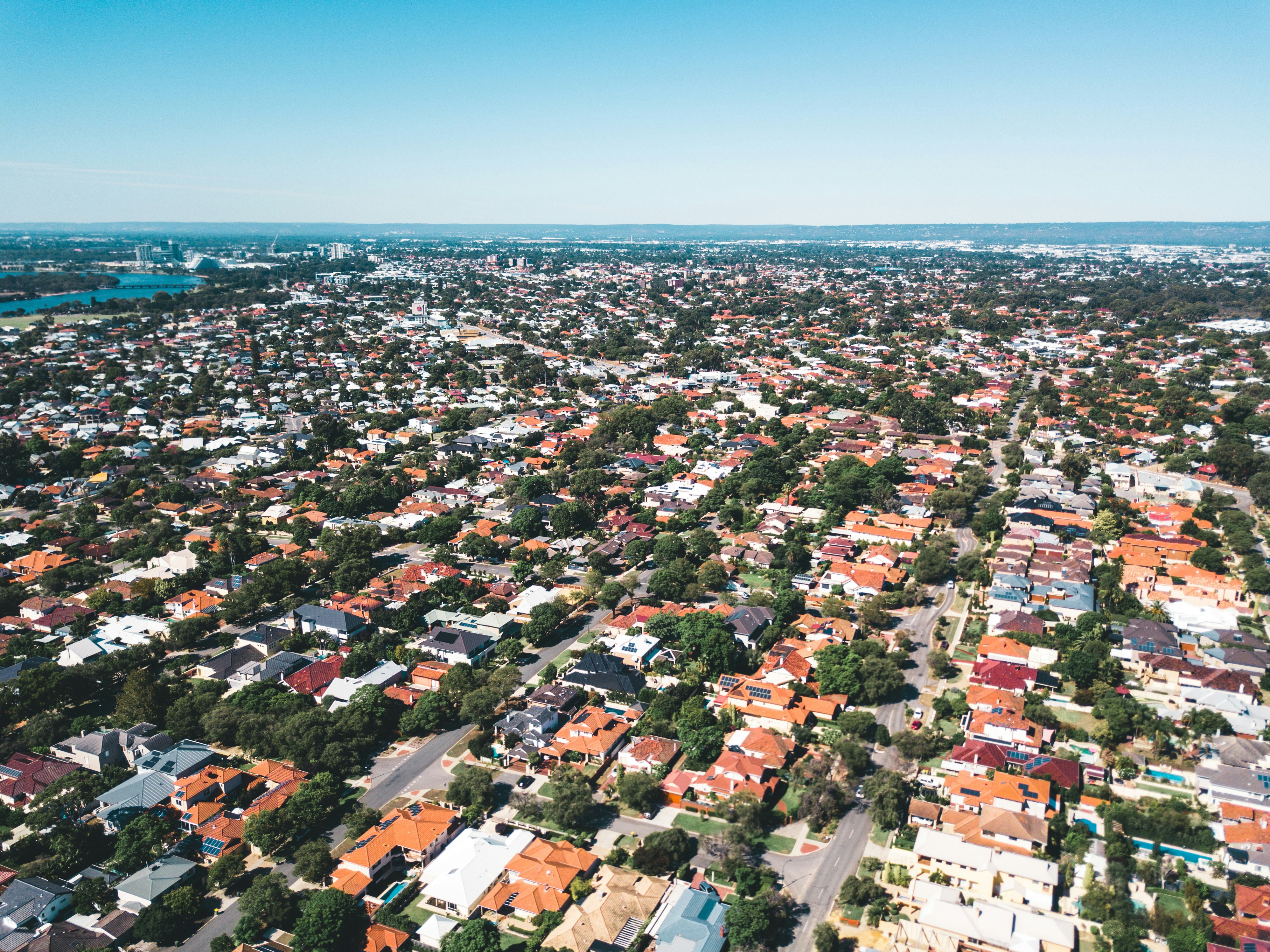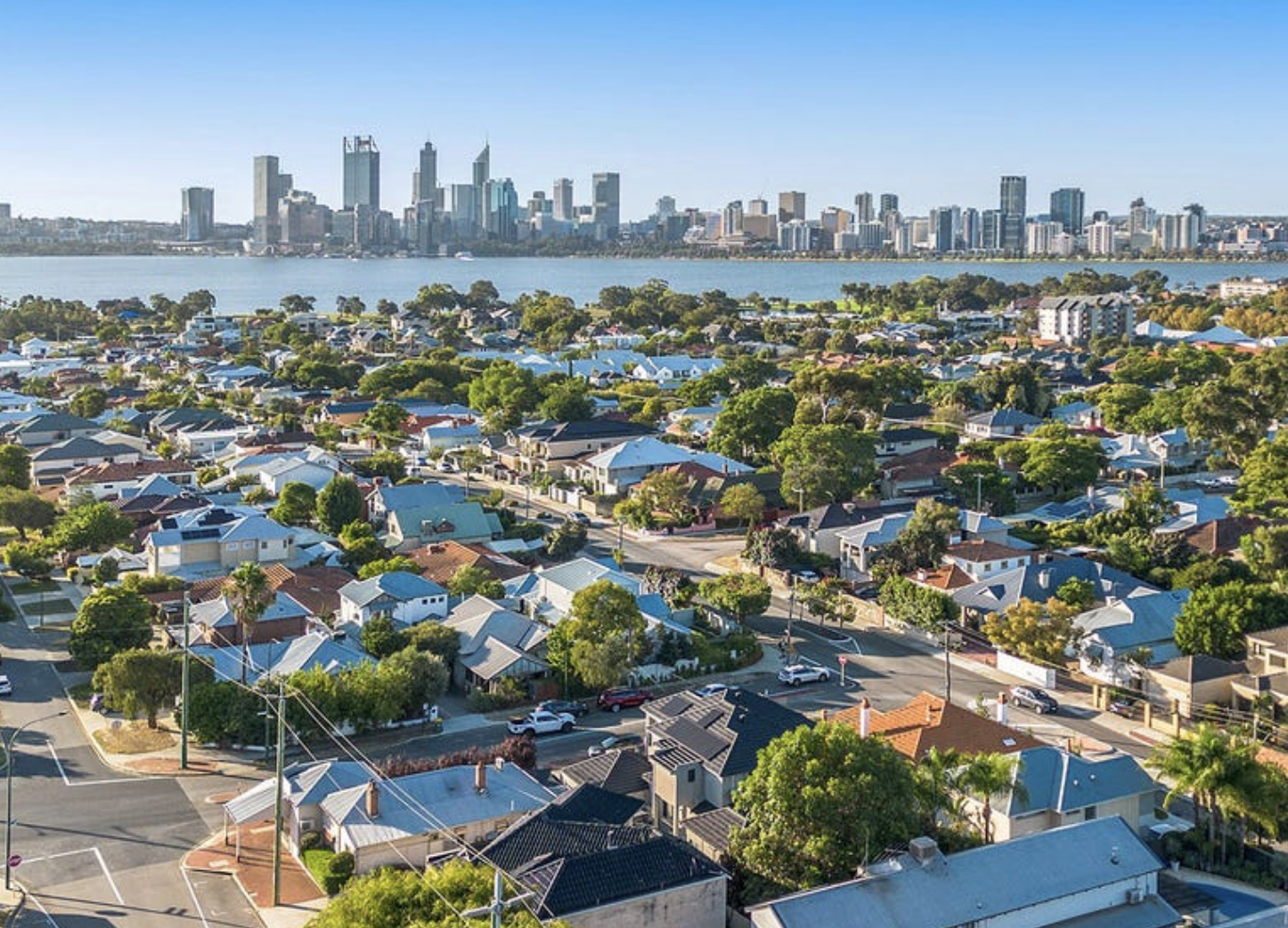Auction markets are showing real strength, with clearance rates reaching 74.4% nationally – the second-highest result we've seen this year. What's particularly interesting is that bidder competition has hit an 18-month high, with an average of 3.1 active participants per property, even during what's normally a quieter winter period.
This increased activity comes at a time when there's plenty happening on the construction front, with new housing starts jumping 11.7% to 47,650 homes, though most of this development is concentrated in outer greenfield areas. Meanwhile, established suburbs with good transport links and development potential are attracting investor attention, especially as Melbourne edges closer to that seven-figure median house price milestone.
Interestingly, some of Australia's strongest property growth is happening in outer suburban locations that many might overlook. New research from investment company Longview shows that certain outer suburbs are significantly outperforming their city averages – with targeted areas in Sydney delivering 7% growth compared to the city's 3.3%, while similar Melbourne suburbs achieved 6% against the broader market's 1.6%. This data highlights the varied performance we're seeing across different locations and property types, particularly as we head into what could be a competitive spring season.
With unemployment ticking up to 4.3% – higher than economists expected and following July's surprise decision to hold rates steady – markets are now pricing in a 92% chance of an August rate cut. These conditions are shaping up for increased market activity ahead.
Key Highlights
- Melbourne recorded 76.6% auction clearance rate – the strongest since May 2023
- National bidder competition reaches 18-month high with 3.1 active bidders per auction
- Older homes on well-located land delivered 7% growth in Sydney (vs 3.3% city average) and 6% in Melbourne (vs 1.6% city average)
- New housing starts jumped 11.7% in March quarter to 47,650 homes – the highest in three years
- Australia faces 262,000-home shortage over five-year forecast period
- NSW Pattern Book launches with 10-day approval process for pre-designed homes
- Unemployment rises to 4.3% (3½-year high), cementing August rate cut expectations at 92%
- Listing volumes down 13% in Sydney and 14.1% in Melbourne, creating supply constraints
This week's data reveals varied performance patterns across different market segments, with supply constraints and strong auction activity indicating continued momentum heading into the traditional spring selling season.
Godfrey Dinh, CEO of Futurerent, emphasises the importance of looking beyond broad city averages: "What this data shows is that city-level statistics can be quite fragmented – the real opportunities often lie in understanding specific sub-markets. We're seeing clear signals in the data with improving auction clearances, ongoing supply shortfalls, and limited stock levels. When you combine this with the falling interest rate environment, it's likely to tip the supply-demand balance toward sellers."
Hidden Growth
Outer Suburbs Outperforming Blue-Chip Areas
New research from investment company Longview has shattered the myth that the best capital growth only happens within 15 kilometres of the CBD. Their index, tracking older dwellings on well-located land, reveals some remarkable performance differences across major cities.
"There's this mythology that all the best capital growth is within 15 kilometres of the CBD. But from a pure capital growth point of view, some [houses] further out have outperformed even the capital growth performance of blue-chip suburbs. People don't notice that." - Evan Thornley, Longview CEO
The data tells a compelling story:
- Sydney: Properties on well-located land rose 7%, more than double the city's 3.3% average
- Melbourne: These properties jumped 6% compared to the overall 1.6% increase
- Brisbane: An 8.2% gain led the wider city's 7% increase
What Makes These Properties Special
According to Evan Thornley, former Victorian state Labor MP and Longview CEO, the key lies in understanding property fundamentals rather than chasing fashionable addresses. He focuses on older homes where more value sits in the land than the dwelling – properties located close to public transport, employment hubs, or activity centres that continue rising in value because of their development potential.
Godfrey Dinh, CEO of Futurerent, sees this trend playing out with his clients: "We're increasingly helping investors recognise that location fundamentals matter more than prestigious postcodes. Many investors are targeting older homes in established areas with genuine long-term development potential rather than chasing the latest trendy suburb."
The pattern is already evident in areas like Windsor and Penrith in Sydney, where established outer suburbs have demonstrated significant growth potential. These areas combine the essential ingredients of accessible transport links, established infrastructure, and land suitable for future development – creating a compelling investment proposition that's often overlooked by investors focused solely on blue-chip postcodes.
Supply Surge
New Housing Starts Jump 12%
Australia's home-building sector is finally showing signs of recovery, with new housing starts jumping an impressive 11.7% in the March quarter to reach 47,650 homes – the highest level in three years.
"Dwelling starts were up again and have been rising since late 2023 and bode well for further increases in housing delivery." - Matt Bell, Oliver Hume Property Group Chief Economist
State-by-State Supply Analysis
The supply boost isn't uniform across the country, with significant variations between states. Junge Ma, senior research analyst at buyer's agency InvestorKit, notes that development is concentrated in specific markets:
"We are seeing most of the development in Melbourne and Perth. Not just in terms of numbers but in terms of rates – the ratio between new houses and the total housing stock."
The approval rates as a proportion of total housing stock over the past 15 months show:
- Melbourne: 30,000 new homes (2.4% of total stock) – the country's highest
- Perth: 18,000 new homes (2.3% of total stock)
- Brisbane: 2.1% of total stock
- Sydney: Just 1.5% of total stock despite being the largest market
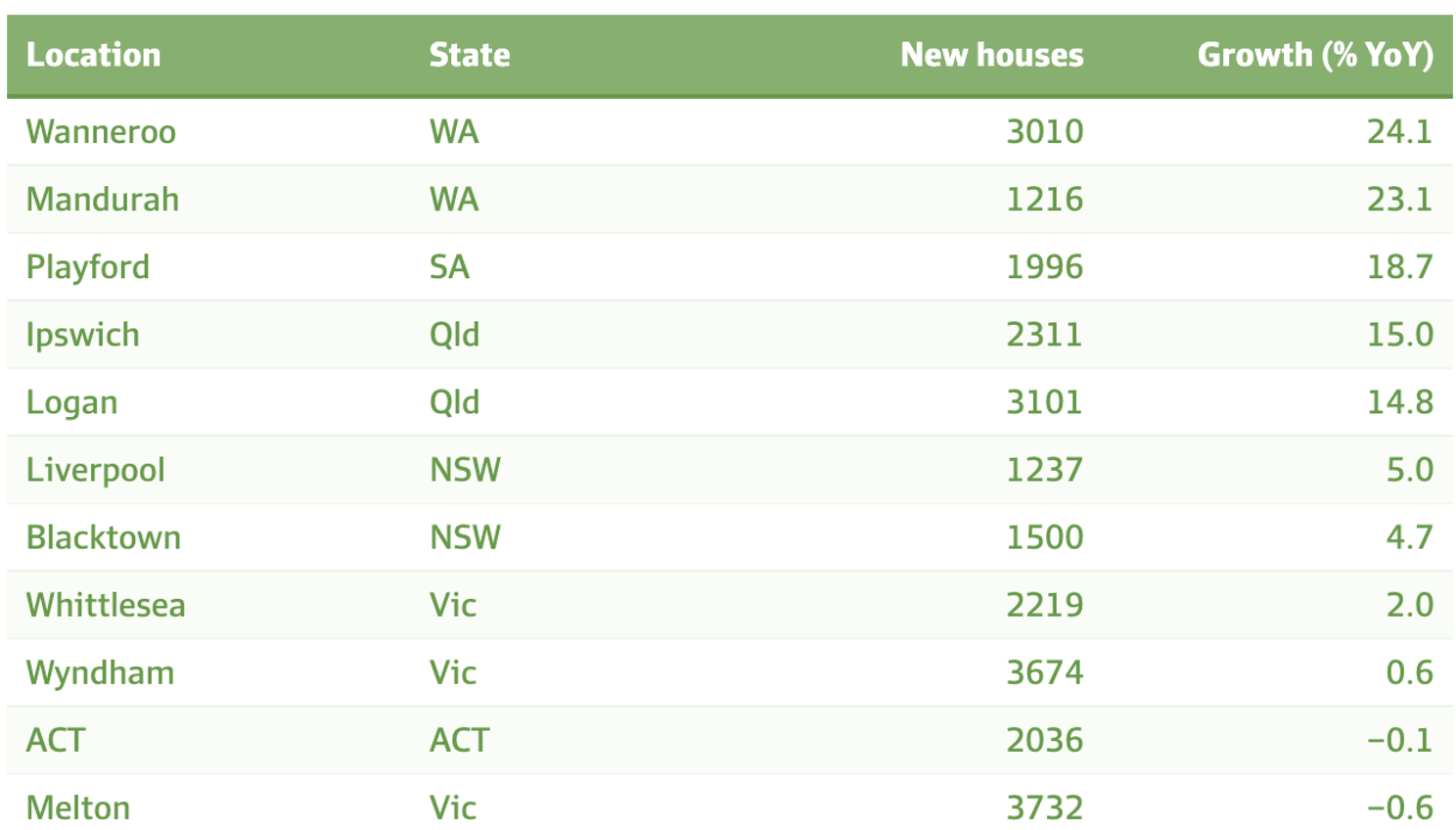
Impact on Different Market Segments
The bulk of new development has occurred in outer-ring suburbs and regional hubs, with mixed results on pricing. Lucinda Hartley, cofounder of Mondus Capital, notes a key insight:
"New housing approvals – particularly detached houses – are not materially slowing price growth." - Lucinda Hartley, Mondus Capital
This is evident in the data: some local government areas in the top 10 for new house approvals still recorded above-average price growth, including Wanneroo in Perth (24% growth), Ipswich in Brisbane (15% growth), and Logan in greater Brisbane (15% growth).
However, the contrast is stark in high-supply Melbourne areas. Melton in outer-western Melbourne actually declined 0.6%, while Wyndham in the city's far northern suburbs managed just 0.6% growth – demonstrating how oversupply can impact specific local markets even as broader city trends remain positive.
Land Value Fundamentals
Understanding the difference between land value and dwelling value is crucial for investors navigating the current supply constraints. As Evan Thornley points out, most property value lies in the land rather than the dwelling, particularly for older, depreciated homes.
The impact of new housing on property values depends entirely on whether development increases land supply or just dwelling supply. This distinction is crucial for investors trying to understand where opportunities lie in the current development boom.
"Will the price of apartments drop if there's a flood of new apartments? Probably yes – you're in the dwellings market. But don't kid yourself that the price of family homes will go down as a result. While that may have an impact on the supply-demand balance for dwellings, you've made it worse for the land. Most of the value is in the land." - Evan Thornley, Longview CEO
This creates two distinct scenarios for property investors to consider:
- Outer-ring development on newly rezoned land: Can hold down prices by increasing both land and dwelling supply
- Density increases around well-located land: Pushes up the value of existing homes near employment hubs or transport nodes
Strategic Implications for Investors
Godfrey Dinh emphasises the importance of understanding this distinction for successful property investment: "Investors holding dwellings long-term still need to think like developers when evaluating properties. The question isn't just 'what's the current value?' but 'what's the future development potential of this land?' Properties with subdivision or density upside in established areas can often outperform long-term compared newer developments on smaller greenfield sites."
The current push by Sydneysiders to amalgamate properties near transport hubs – taking advantage of higher prices from combined development sites under NSW's new planning changes – demonstrates how demand for well-located land is already driving higher prices. This trend reflects a sophisticated understanding of land value that individual investors can also harness by targeting properties with similar potential on a smaller scale.
Auction Momentum
Melbourne Leads with Strongest Results in Two Years
Australia's auction markets are showing remarkable strength, with Melbourne recording its best performance since May 2023. The combined capital city preliminarily clearance rate reached 74.4% across 1,574 auctions – the second-highest result this year and up from 72.2% reported the previous week.
City-by-City Performance
Melbourne led the charge with impressive week-on-week improvements:
- 678 homes went to auction (up from 628 the previous week)
- 76.6% preliminary clearance rate – the highest since May 2023, according to Cotality research director Tim Lawless
- Sustained momentum building through winter months
Sydney maintained strong performance despite a slight softening:
- 587 homes auctioned (up from 556 the previous week)
- 74.8% clearance rate (down from 76.2% the previous week)
- Sixth straight week of preliminary clearance rate above 70%
Despite the positive clearance rates, Ray White Group managing director Dan White identifies concerning trends in listing volumes that suggest the market's strength may be masking underlying weaknesses:
"Even though what's coming on the market is being received well and the results are strong, the volume side of the market, which is obviously the good telltale of the overall strength of the market, is soft. Our listing authorities across the board are down about 20 per cent year-on-year, which is a pretty big drop normally." - Dan White, Ray White Group
White suggests prospective sellers may be waiting for further interest rate reductions or were spooked by the Reserve Bank's decision to hold rates steady in July. This creates a paradox where strong clearance rates might actually reflect limited choice rather than genuine market strength, with successful sales occurring simply because there are fewer properties available for buyers to choose from.
Bidder Competition
Competition Reaches 18-Month High
The average number of bidders at auctions nationwide has reached its highest level in 18 months, with Ray White data showing an average of 3.1 active bidders and 4.7 registered bidders for every property auctioned in June.
To put this in perspective, the current competition levels remain well below the market peak of September 2021, when cheap money and COVID-19 upheaval drove 4.1 active bidders and 8.4 registered bidders to each auction. However, the steady increase through 2025 signals growing buyer confidence.
State-by-State Bidder Analysis
Competition varies significantly between states:
- NSW: 4.8 bidders registered, 2.9 active bidders
- Victoria: 3.7 bidders registered, 2.9 active bidders
The number of bidders at auction nationwide has been rising in 2025
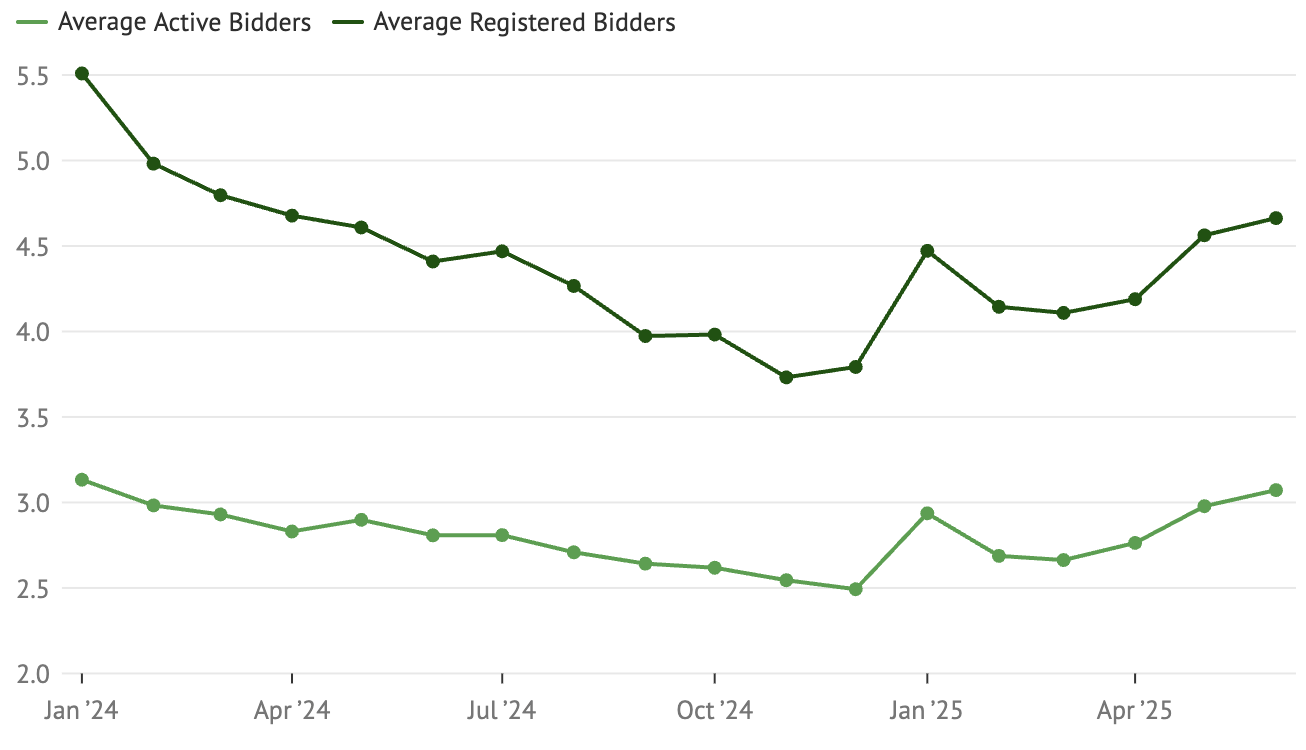
The higher registration in NSW suggests buyers are doing more homework before committing to active bidding. Rader explains the Sydney market dynamics:
"In Sydney, we continue to see price growth, although it is not to the same extent as other markets. Now that the interest rate has improved, buyers think they might as well jump in. Prices aren't going backwards." - Vanessa Rader, Ray White Head of Research
Driving Forces Behind Increased Competition
Ray White head of research Vanessa Rader identifies two key factors driving the competition surge:
"If you look at listings numbers, they have been consistently low this year, so that if you're looking to buy something, the volume of stock just isn't there. The second piece to that is the sentiment around interest rates. People do expect to see multiple interest rate reductions this year. That has fostered increased confidence in the market – buyers know they can't sit on their hands for long." - Vanessa Rader, Ray White
Winter Buyers Getting Ahead
Apollo Auctions general manager Greg Brydon notes that winter buyers are strategically positioning themselves:
"Buyers seem cognisant that if another interest rate drop does come, there's every likelihood there's going to be more competition in the market. Even though they might be stretching their budgets just a little bit now, it's probably better than stretching it quite considerably in the months to come." - Greg Brydon, Apollo Auctions
Edward Riley from Edward Riley Auctions confirms the energy shift: "We're seeing stronger auction attendance, and far more consistent bidding patterns as well. It feels like the energy is back, and I think we're gearing up for a busy spring."
Rate Outlook
August Cut Almost Certain After Jobs Data
The Reserve Bank's decision to hold rates steady in July shocked money market traders who had priced in a 95% chance of a cut. However, subsequent employment data has all but guaranteed an August reduction.
Unemployment Jumps to 3½-Year High
The unemployment rate jumped to 4.3% in June, up from 4.1% in May – worse than economist forecasts and confirming the jobs market is cooling.
"In our view, the labour market data released since the July board meeting would support a rate cut in August." - Adam Boyton, ANZ Economist
Market Expectations Reset
Following the employment data, traders have reset their expectations:
- 92% probability of an August cut (RBA meets August 11-12)
- Markets remain confident despite July's hold
- Some economists expect cuts to continue beyond August
Capital Economics senior economist Abhijit Surya expects aggressive easing:
"With the unemployment rate having surged in June and timely indicators suggesting that activity and inflation both remain subdued, the bank will almost certainly resume its easing cycle in August." - Abhijit Surya, Capital Economics
Surya forecasts the cash rate falling to 2.85%, below the 3.1% low point predicted by other economists.
Housing Shortage
Australia Faces 262,000-Home Shortfall
The National Housing Supply and Affordability Council's State of the Housing System 2025 report reveals Australia is on track to fall 262,000 homes short of its five-year target, despite lower interest rates and stable costs improving conditions.
Current Supply vs Demand Gap
The shortage reflects a fundamental imbalance:
- 177,000 dwellings completed in 2024
- Underlying demand estimated at 223,000 for the same period
- Supply near its lowest level in a decade
Five-Year Forecast Challenges
After accounting for demolitions (forecast at 113,000 over five years), the Council projects a significant shortfall that will continue to pressure housing affordability:
- Net new housing supply: 825,000 homes
- New household formation: 904,000 households
- Shortfall: 79,000 dwellings
What’s being built and when (‘000)
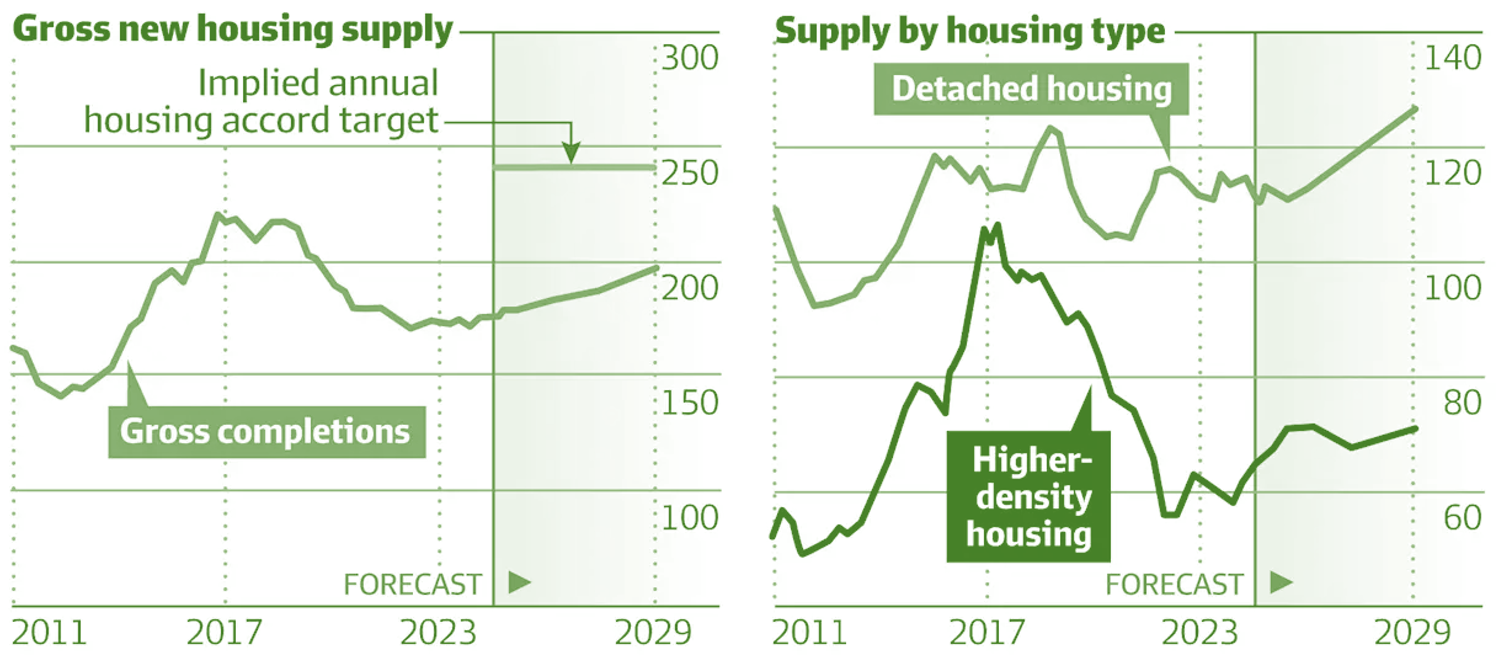
This structural imbalance means that even with increased construction activity, Australia will struggle to meet the basic housing needs of its growing population, creating ongoing support for property values.
Housing Mix Problems
The high cost of building is shaping construction toward less efficient housing types:
- Two-thirds will be detached houses (rising to a three-decade high)
- Just one-third will be denser attached housing (apartments and townhouses)
Gross new housing supply by state and territory
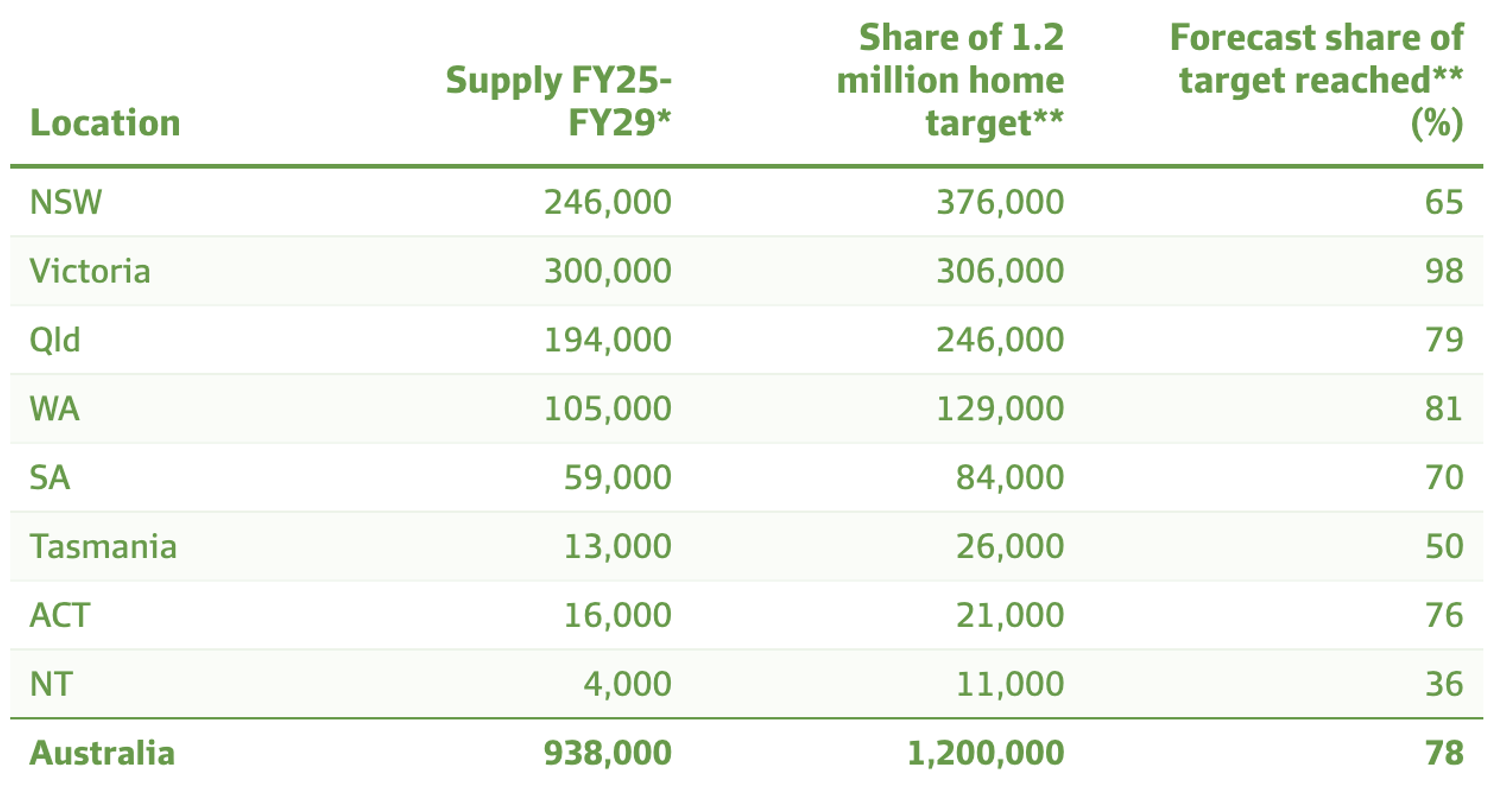
*Forecast **Council estimates
Council chair Susan Lloyd-Hurwitz emphasises the density challenge:
"We absolutely need that form of housing. We know the rate at which we're providing higher- and medium-density housing is roughly half of what it was in 2017 and is due to feasibilities being stretched for developers given interest costs, construction costs and so forth." - Susan Lloyd-Hurwitz, National Housing Supply and Affordability Council
Godfrey Dinh sees opportunity in this challenge: "The housing shortage creates a structural tailwind for property investors, particularly those targeting areas with development potential. While governments focus on broad housing targets, smart investors can position themselves in locations where density increases are most likely to occur."
Fast-Track Approvals
NSW Pattern Book Revolution
The NSW government has launched its housing pattern book featuring eight pre-approved designs for low-rise terraces, townhouses, and four-dwelling manor houses, promising 10-day approvals that councils cannot overturn.
Design and Approval Process
The new system offers significant advantages for developers and investors:
- Pre-approved designs available for download (initially $1, rising to $1,000 after six months)
- 10-day approval timeframe guaranteed
- Applies to 172 nominated town centres for low and medium-density housing
- Flexibility built in for site-specific conditions (orientation, topography, shadowing, water run-off)
"The pattern book will slash development application assessment times. It is particularly useful in the 172 town centres which have been nominated for low and medium density housing." - Tom Forrest, Urban Taskforce CEO
Victorian Success Story
Victoria introduced similar fast-track approvals earlier this year with impressive results:
- February: Fast-track approvals for townhouses and buildings up to three storeys
- April: Regime for proposals between two and eight storeys
- Result: 42% jump in multi-dwelling applications between April and June
Urbis director of urban planning Mick Meyer explains the appeal:
"The carrot is in the pathway. If they can make the pathway attractive, property developers will move forward." - Mick Meyer, Urbis
Historical Context and Future Impact
Architect Shaun Carter notes that pattern book suburbs aren't new – popular Sydney areas like Paddington, Surry Hills, Balmain, and Haberfield were pattern book developments from earlier eras where "builders had the catalogues and you'd specify your terrace or bungalow from their catalogue."
"If it is getting approval in 10 days, then the only question is how quickly you can organise yourself to get started." - Shaun Carter, Architect
The initiative forms part of NSW's broader planning overhaul allowing bigger developments near train stations, aiming to build 377,000 new homes by 2029.
Market Dynamics
Listings Decline Creates Supply Squeeze
Despite strong auction results, listing volumes are declining across major markets, creating a supply squeeze that's supporting prices and increasing competition.
Sydney Market Conditions
PropTrack's June 2025 Listings Report reveals concerning trends that reflect broader market hesitancy:
- New listings down 13% month-on-month
- Current listings 5.2% lower than last year
- Properties spending longer on market despite strong clearance rates
Many of the homeowners delaying plans to sell their homes are likely to also be buyers, with upsizers and downsizers normally making up a significant share of the buyer pool. This creates a compounding effect where reduced listings also mean fewer active buyers in the market.
PropTrack economist Angus Moore explains the anomaly:
"The fact we're seeing a bit more stock on market despite a smaller flow of new listings reflects homes taking a little longer to sell than they were a year ago. Though the difference isn't large, and homes are still selling faster than they were pre-pandemic." - Angus Moore, PropTrack
Melbourne Following Similar Pattern
Melbourne is experiencing parallel trends with concerning implications for future supply:
- New listings down 14.1% in June compared to May
- 4.4% decrease in new listings over 12 months to June
- Total Melbourne listings declined 5.8% from June 2024 to June 2025
- Auction numbers expected to be 19% lower than last year this week (666 auctions forecast)
- Median house price reached $979,979 in June (up 1.6%)
Industry experts are now predicting Greater Melbourne's median house value could top seven figures before December – a significant milestone that would further stretch affordability for many buyers.
Moore expects the listing situation to improve as rate cut expectations become reality:
"We're expecting to see a couple more rate cuts this year – coupled with the fact Melbourne home prices have been consistently increasing this year for the first time since the RBA started raising rates, that's likely to support vendor confidence." - Angus Moore, PropTrack
Days on Market Declining
Despite listing concerns, properties are selling faster in key markets compared to pre-pandemic timeframes:
- National average: 37 days for houses, 35 days for units
- Adelaide leads: 22 days for both houses and units
- Brisbane: 31 days for houses, 28 days for units
- Sydney: 30 days for houses, 32 days for units
- Melbourne: 31 days for houses, 34 days for units
How long it takes to sell a house compared to last year
Median days on market in the 12 months to June 2025
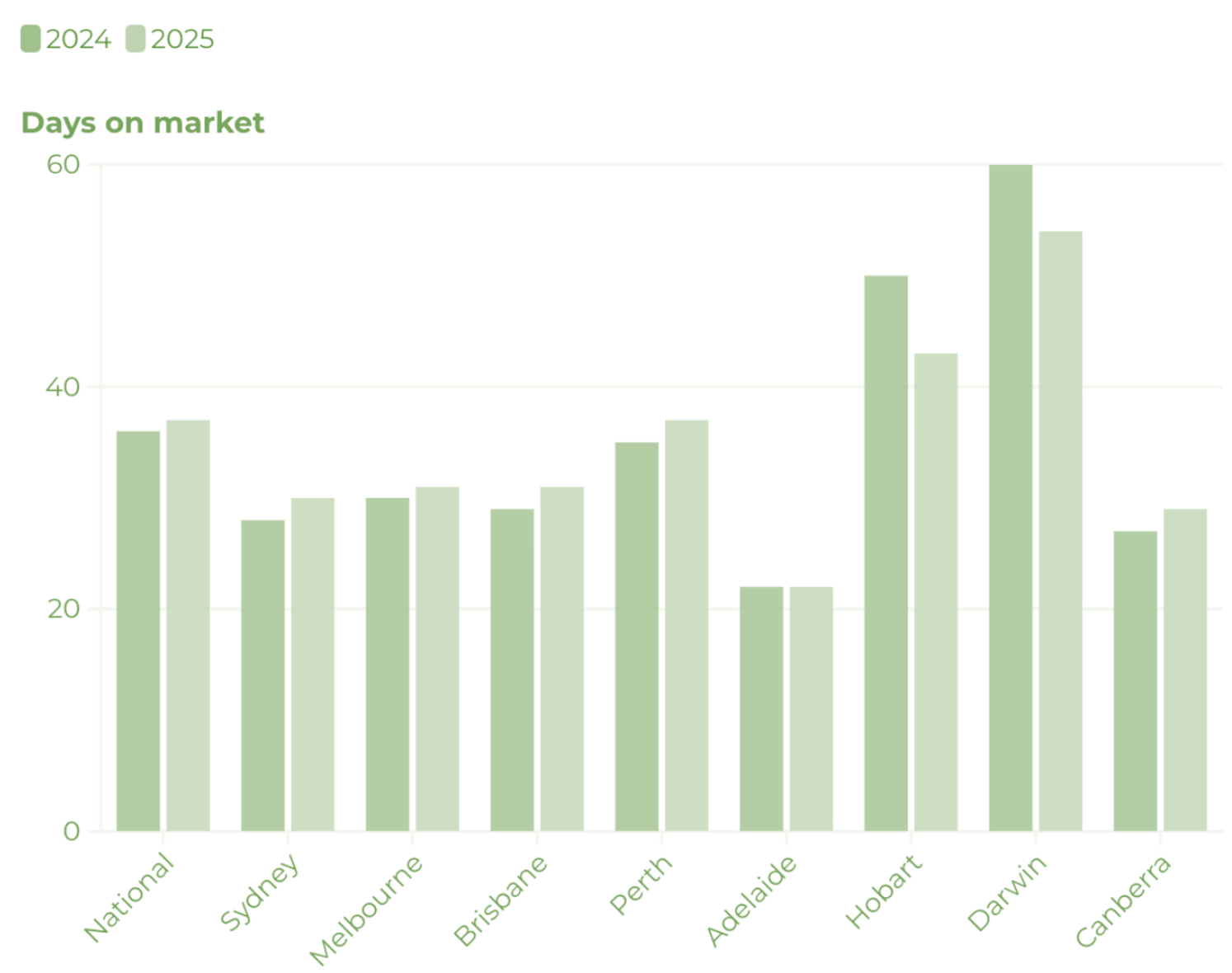
Where properties are selling much quicker than last year
PropTrack data reveals 40 suburbs across the capitals where selling times have plummeted dramatically, with some properties selling twice as fast as a year ago. Many of these high-demand areas are found on the fringes of Sydney and Brisbane, offering affordability or value for money with larger, spacious properties.
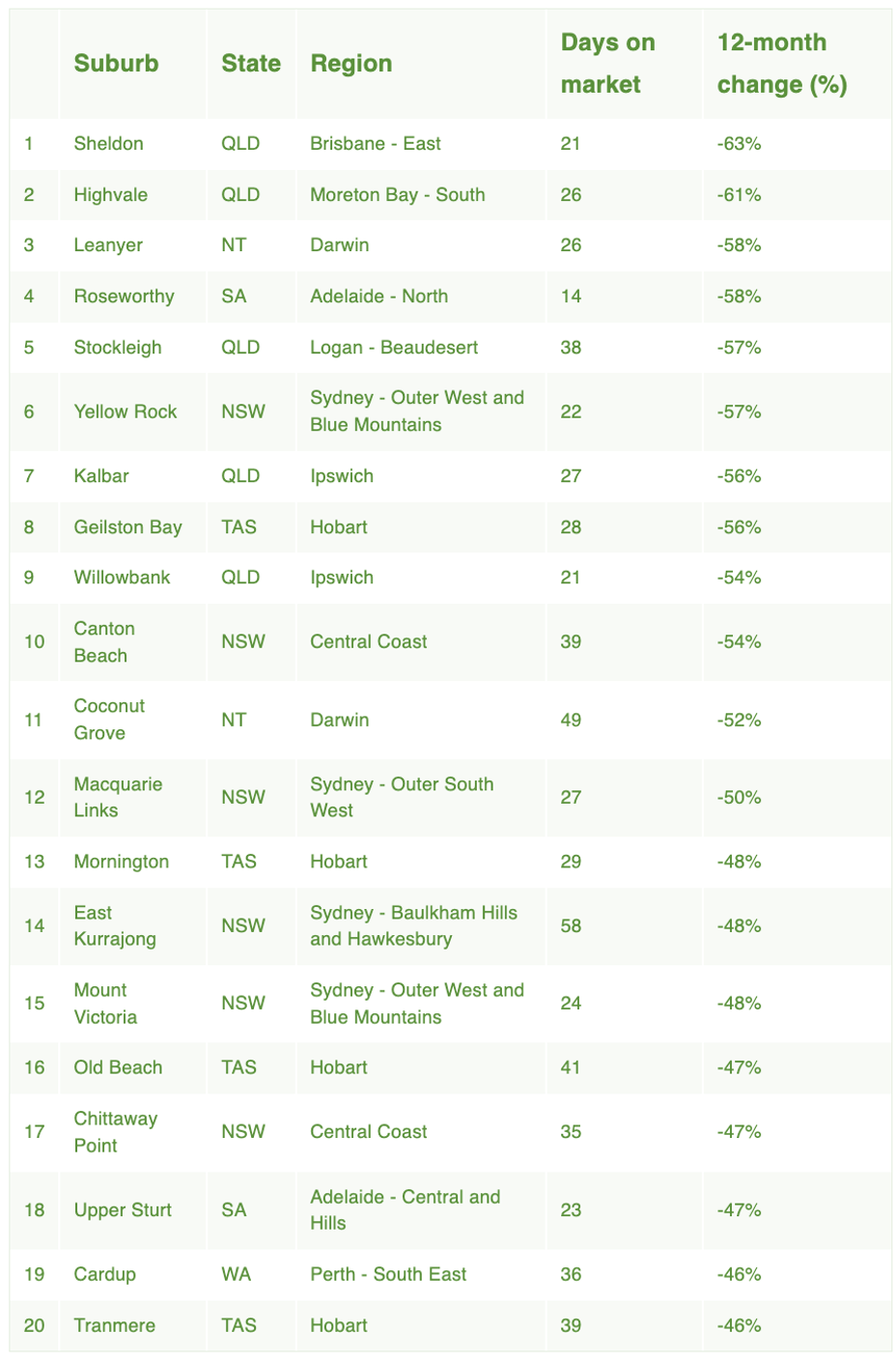
REA Group senior economist Anne Flaherty explains the significance:
"Where we see demand tracking up, we see days on market going down." - Anne Flaherty, REA Group
Strategic Implications
Investment Opportunities in Changing Market
The current market presents several strategic opportunities for property investors willing to look beyond traditional investment wisdom.
Focus on Land Value Over Postcode Prestige
Evan Thornley's research demonstrates that development potential matters more than prestigious addresses in today's market environment. Investors should target:
- Older homes on well-located land near transport hubs
- Properties with subdivision or density upside potential
- Established suburbs with infrastructure but limited recent supply
- Areas benefiting from government planning changes
The key is recognising that in many cases, a modest home on well-positioned land in an outer suburb may deliver superior returns to an expensive apartment in a fashionable inner-city location, particularly when development potential is factored into the equation.
Multiple factors create timing advantages for active investors:
- Limited listing volumes reducing competition for well-positioned properties
- Winter market providing less competition than spring will bring
- Interest rate cuts expected to increase buyer competition
- Supply constraints likely to persist despite new development
Godfrey Dinh advises: "The smart money is moving now, before spring competition intensifies and before further rate cuts bring more buyers into the market. Winter provides a window for investors to secure well-located properties at better prices with less competition."
How Futurerent Can Help
Property investors know that prices grow faster than you can save. And even with a foot on the property ladder, taking the next step shouldn't mean asking the bank's permission or signing up to another lifetime of interest when all you need is to unlock what's already yours.
What if you could access that equity without refinancing, selling the property, or waiting until it's too late?
That's why investors turn to Futurerent - to unlock their equity without the usual trade-offs. There's no refinancing, no painful paperwork, and no impact on your credit score.
Futurerent helps investors cash out up to $100,000 per property, with funds in your account in just 2 business days. The property returns the cash out from a fixed portion of the rent over 3 years.
With market conditions suggesting significant opportunities ahead, having quick access to capital could make all the difference in securing your next investment before prices potentially move higher.








